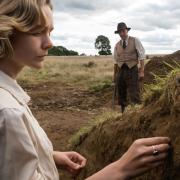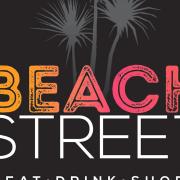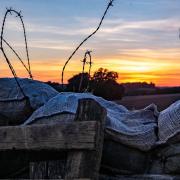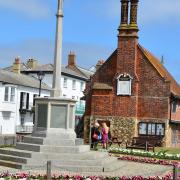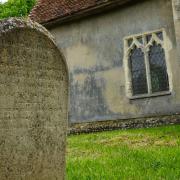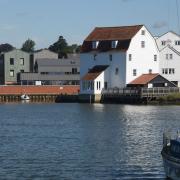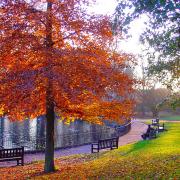From the Waterfront to Westerfield, Lindsay Want discovers tales of brewers and barges, pinnacles and parks on a town and country station to station walk, incorporating the Fonnereau Way

What makes a really good winter walk? A crystal-clear blue Suffolk sky. A warm woolly hat. Well-trodden paths. Perhaps a little country crunch of frost? Bobbing boats and water glinting with sharp sparkles of sunlight.
Valley vistas which satisfyingly fall away where your footsteps have been. How about a helping of history or stately something? An occasional café hotspot, welcoming watering hole? Oh, and a squirrel or two! Where to find such a winter wander-land? Well, to echo the words of its tourism motto: “Ipswich – you’ll be surprised!”
Cobbling together past and future
Alight by the River Gipping in the centre of Suffolk’s county town and it’s soon clear that Ipswich has all the ‘quay’ ingredients. As the river’s last tidal stretch morphs into the mighty Orwell, along the Waterfront’s quayside cobbles, a world of maltings and merchants, colleges and would-be kings unfurls like the sails of Victor, the great Thames barge moored before the historic Custom House.

It surely sits in memory of barges built here and the fleets of days gone by. A sea port since the 7th century, once a king’s port fabricating fighting ships for the crown, here was home to Thomas Eldred who navigated the globe in the 1600s and a place familiar to New World pioneers and Lord Nelson alike.
Tucked away near the DanceEast’s enticing fishbowl of a café, a ‘window museum’ exhibition carefully shared by the Ipswich Maritime Trust puts fascinating harbourland histories humbly on display.
And further along the quay, Isaacs, a Grade II* listed warehouse complete with malting kiln, offers plenty of food for thought – perhaps the moment to ponder how the town’s fresh spring water once attracted Cobbold’s brewery to down-river Cliff Quay, or why 19th century barges shipped in Apollinaris mineral water all the way from Remagen in Germany.
Colleges and kings
Turn your back on a port which played a prominent role in Suffolk’s medieval wool trade and weave your way through the place where Ipswich’s (in-)famous Tudor butcher’s boy, Thomas Wolsey, nearly established a magnificent seat of learning. Its gate is still on College Road and the cleric’s high status is gently recalled in the warm-red hues of the waterfront’s towering modern apartment block, Cardinal Lofts.

From the wellbeing centre at St Mary at Quay, to the tourist information hub at St Stephen’s, and St Lawrence’s Realise Futures Café, many of Ipswich’s medieval town centre churches have been reverently re-purposed. Heartwarming stuff, just like the magnificent Ancient House that’s iced up to the eye-balls in tale-telling decorative plasterwork outside, and inside sells everything you’d need for a great Suffolk bake off!
Rumour has it that Charles II hid up here with the Sparrowe family in 1651 after the Battle of Worcester. But then Ipswich is full of tall stories.
Onwards and gently upwards, through the taverners’ patch associated with the Ipswich wine merchant ancestors of that prestigious Canterbury tale-teller, Geoffrey Chaucer. Past that pinnacle of Victorian remastering, St Mary-le-Tower with its 60 metre spire, to where the Tudor red bricks of Pykenham’s Gatehouse mark the residential spot of another significant Suffolk clergyman on Northgate Street.
Spot the tiny plaque on a nearby solicitor’s office which announces that the fine timber-framed building adorned with exquisitely carved beams was once the rambling Oak Inn. Around the corner, in Old Foundry Road, is the site of the former Ransomes, Sims & Jefferies factory, the maternity ward of the world’s first ever lawnmowers.

When it comes to great lawns and mighty oaks, Grade II listed Christchurch Park across the road is surely a delightful wander-land all of its own. Blessed with not one, but two fantastic arboreta, vintage oaks, veteran sweet chestnuts and even a 600-year-old yew tree, the 70-acre green space has been encouraging folk to enjoy the countryside right in heart of town since its debut as Ipswich’s first public park in 1895.
With historic ponds and wildlife areas fed naturally, it’s the sort of place which can’t help putting a spring in your step as you walk through on its ancient Saxon track way.
Stop to watch the skittish squirrels playing chase around tree trunks. Pause to ponder a priory site destroyed at Wolsey’s will and subsequent parklands visited twice by Elizabeth I, where Charles II played bowls and Prince Albert went for a stroll after visiting Ipswich School.
Merchants, vintners and great families of brewers all left their mark here over the centuries, modelling the pleasure gardens and adding their own touches to the magnificent Elizabethan manor house. Meet them all – the Withypolls, Devereux, Fonnereaus and Cobbolds – adorning the walls of Christchurch Mansion, an outstanding stately home of a museum that’s free to visit, where you’ll surely want to wander around for a while.

Take a look at Gainsborough’s watery Ipswich scene of Holywells Park, Constable’s Stour Valley landscapes and even a Lowestoft Porcelain tea set perhaps. Or just head for the scullery café – the last sheltered spot to warm the cockles with a hot chocolate, before embarking on the more exposed countryside miles to come.
Tread the tarmacked paths up through Christchurch Park, turning to take in the fine view back over the Ipswich towers and pinnacles, as you follow the route remembering the notable Fonnereau family out of town, through tree tunnels and along farmland margins, towards the northerly village that goes by the somewhat disorientating name of Westerfield.
Beyond Grove Farm, you’ll count your lucky stars that the Ipswich Corporation and Borough safeguarded Christchurch Mansion, as you look across the fields and realise how the stately Red House, famed for fine Venetian windows, met with demolition in 1937.
Beyond today’s railway line, the village smock mill met a similar fate in 1819, just years after the village green – a place once filled with the rural excitement of cricket or football, donkey races and George III’s review of 10,000 troops – had surrendered itself to the Enclosures Act.

Breathtaking discoveries of sorts, but none quite as bracing as life on the ledge, when you walk up along the valley ridge to stand like Ipswich’s answer to the Angel of the North on the concrete plinth of the triangulation point.
It’s an obvious spot to survey the lie of the land towards town, but then the angels’ wings of St Mary Magdalene’s single hammer-beam roof, the soft warm embrace of The Swan or nostalgic welcome of the Railway Inn are only a footpath and pavement away. Westerfield is somehow wonderfully a world apart from the hubbub and histories of Ipswich, yet just an eight-minute, sweeping curve of a train ride back towards the water’s edge.
The Walk
1) Leave Ipswich railway station, turning left. Cross the road and go over Princes Bridge. On the left, just after the bridge, follow the footpath sign (Stoke Bridge & Historic Waterfront) down the steps to the riverside path. Go left, under the bridge alongside the tidal river, past St Mary at Stoke (right) and the site of Stoke Mill (opposite the skate park) towards the tall buildings of the Waterfront.

2) At Stoke Bridge, cross Bridge Street to enter St Peter’s Dock. Follow the ‘Never Ending Mural’ along the quayside, past the Jerwood Dance House, the Ipswich Maritime Trust display and skeletons of concrete buildings sprouting trees Hundertwasser-style en route to Albion Wharf.
3) Just before the grand Custom House, turn left. Keep left along Key Street to cross just beyond St Mary at Quay (Quay Place). To see Wolsey’s Gate, turn left alongside the busy road to find it just before St Peter’s. Otherwise, go straight ahead down the side of St Mary’s (Foundation Street), cross over Star Lane and at the junction of streets, fork left into Lower Brook Street by the information/map board.
4) Spot The Masters House (right - 1786 birthplace of William King, pioneer of the Co-operative movement), then the unusual 1903 gateway of Suffolk Victoria Nursing Institute. At the T-junction, turn left into Dog’s Head Street towards the bus station, then first right into pedestrianised St Stephen’s Lane.
5) Don’t miss the late perpendicular and Tudor styles of the Tourist Information Centre (St Stephen’s Church). Work out which Continent isn’t depicted in the pargetting of the Ancient House and why, then pass the tower of St Lawrence in Dial Lane which houses the Christian world’s earliest ring of five bells. Cross over Tavern Street into Tower Street (Geoffrey Chaucer plaque on right) and turn right into the little alley way (Tower Church Yard) just before St Mary-le-Tower. Snake left, then right.

6) The great timbered property with superbly carved corner posts is Oak House. Turn left along Northgate Street, pass Pykenham’s Gatehouse built in 1471 by the Archdeacon of Suffolk. At the end of the road, turn right to cross over into St Margaret’s Plain. Go briefly right, then fork left by the half-timbered building on a little island of houses into Soane Street to find the gates to Christchurch Park.
7) Christchurch Park (open from 7am, gates locked around dusk) - the official start of the Fonnereau Way, a board on the park wall introduces the distinctive Fonnereau coat of arms. Maps also show key locations around the park. The historic round pond was originally the priory’s fish stock pond and is well-documented in Fonnereau’s 18th century era, but the magnificent Grade I listed redbrick mansion steals the show. Follow the main path uphill past the mansion (right), keeping left until it becomes a straight tree-lined path.
8) Exiting the park, cross over Park Road to continue straight ahead along The Avenue through a residential area to meet Valley Road. Cross with care and turn left.
9) Look out for the footpath (right) just beyond the entrance to Ipswich School’s playing field. At the end of the narrow path, turn right towards the playing field, then left to keep straight ahead along field edge paths.

10) For a shorter walk, turn right down the field edge path to meet Westerfield Road. Turn left along the pavement to get to Westerfield railway station. To continue to the village, follow the Fonnereau Way signs, crossing the railway line with care.
Here, the cross-field path reveals views of valley slopes ahead. In the next rough meadow, keep left along the edge to meet a sleeper bridge tucked away in the corner by a fence panel, denoting access to Broad Acres Farm. Take the footpath gate onto the farm driveway to Lower Road.
11) Cross Lower Road. Go left to take the bridleway uphill past the waterworks (right). At the hilltop footpath crossroads, go right along the ridge (hedge left).
12) Enjoy the views, before continuing to the field corner. Turn right, taking the second footpath (signed yellow arrows) along a close-boarded fence to Westerfield Road.
13) Turn right along the pavement, past White Lodge and Lilac Cottage to the crossroads to take your pick between The Swan pub or the pond and church (14). Continue to Westerfield Station with its nostalgic former railway buildings and the Railway Inn (15).
____________________




